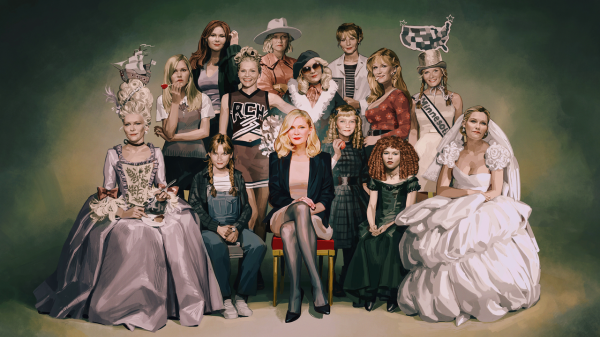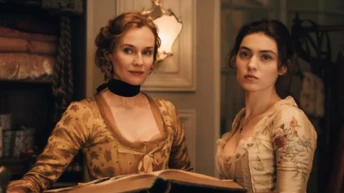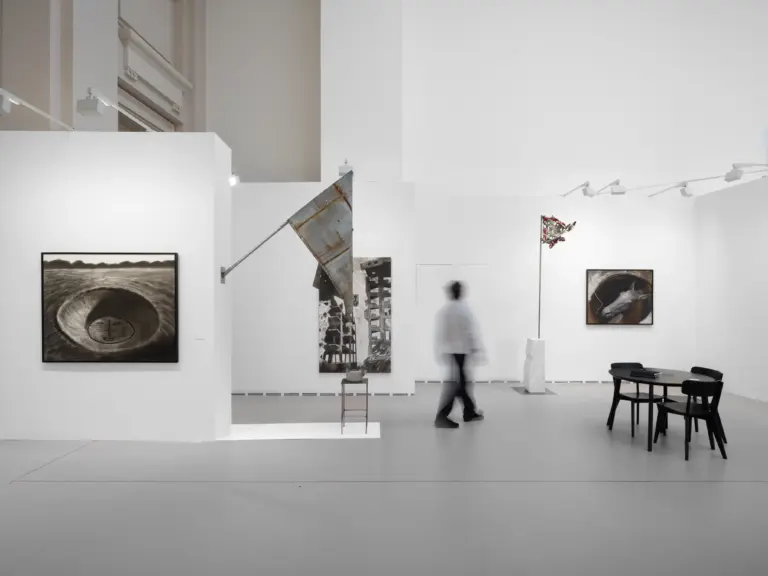
Save this storySave this storySave this storySave this story
You may have seen the recent meme involving the phrase “the feminine urge to,” followed by some pithy example of melancholy or chaotic behavior. “The feminine urge to stop replying to texts and sit in solitude for months at a time.” “The feminine urge to say it’s O.K. when I’m hysterically crying.” The humor—you don’t laugh so much as hiss through your teeth—is that being a woman in the world is regularly so absurd and paradoxical that impulsive, inscrutable gestures are the only logical response. I thought of this phrase the other night, when I rewatched Lars von Trier’s apocalyptic 2011 drama “Melancholia.” The film stars a twenty-nine-year-old Kirsten Dunst in the role of Justine, a bride who is struck by a debilitating wave of depression on her wedding day. In the middle of her own lavish reception, she ducks out to take a hot bath. As dozens of people, including her new husband, are waiting on her to cut the cake, she is upstairs soaking, her strapless corset dress crumpled on the bathroom floor like a wad of discarded notebook paper. The words suddenly popped into my head: the feminine urge to spend your wedding night in the tub. Afterward, Justine slips back into her dress and continues her cavalcade of nonsensical behavior. She has sex with a stranger on a golf course while the wedding guests are inside, eating dessert. She keeps disappearing and reappearing like an apparition, a living ghost bride. The premise of “Melancholia” is that a giant oncoming planet is about to annihilate the Earth. But the incomprehensible outrageousness of celestial disaster is conveyed most acutely through Dunst’s subtlest of facial twitches and glances. Even in the maelstrom, she is magnetic, almost luminous, exerting her own planetary gravity.
For three decades, Dunst has been one of our preëminent performers of conflicted, jumbled femininity. A native of New Jersey, Dunst began doing catalogue shoots and small commercial jobs when she was a toddler. At the age of eight, she played Tom Hanks’s daughter in Brian De Palma’s “The Bonfire of the Vanities” adaptation, a part that prompted her family to move to Los Angeles and camp out at the Oakwood apartments, an infamous child-star launching pad. But it was her performance as the young vampire Claudia, in Neil Jordan’s 1994 adaptation of the late Anne Rice’s “Interview with the Vampire,” that marked her not just as a tween actor to watch but as a fully embodied scene-stealer. In the film, Claudia is made immortal by two adult vampires (Tom Cruise and Brad Pitt) who resolve to treat her as their child. At first, she revels in her transformation, becoming a bloodthirsty little priss with golden ringlets. But she soon grows infuriated with her inability to age. “Do you want me to be a doll forever?” Dunst yells at her guardians, her button nose flaring with fury. She doesn’t want to eat a woman—she wants to be her. Jordan’s film is splattery and silly, but Dunst’s shockingly mature performance transcends its setting. She packs enough sorrow into her tiny frame to convince the viewer that she’s been alive and suffering for thousands of years. Dunst told me recently over the phone, “I probably had that old-soul quality in my eyes, but that eventually caught up with me.”
Critics have not always known what to do with Dunst’s uncanny ability to channel scrappy, girlish ennui. She is finally, after almost three decades in the business, receiving critical-awards buzz for her role as an unravelling housewife in Jane Campion’s new film, “The Power of the Dog.” It has become almost commonplace to hear her lauded as one of the great actors of her generation. But Dunst, in many ways, is still working her way back from a peculiar slump that began when she starred in a handful of poorly received films in her twenties. Before that, Dunst seemed to be everywhere in Hollywood at once, stealing limes in “Little Women,” leaping into board games in “Jumanji,” applying maquillage to corpses as a mortician’s assistant in “Drop Dead Gorgeous,” making a morbid pact with her sequestered sisters in “The Virgin Suicides,” or shaking pompoms in “Bring It On.” (During our conversation, Dunst asked my age, and when I answered she said, “Oh, so you grew up with me in your face.”) But, like many actors who begin their careers young, her résumé, at some point, started to seem scattered, uncertain—Cameron Crowe’s widely panned “Elizabethtown” didn’t help—and her talents began to slip through the cracks.
This is not to say that there haven’t been lacklustre performances. In her weakest films, Dunst’s knack for conveying pain can express itself as a viperous priggishness, such as her performance as the insufferable, holier-than-thou Wellesley priss Betty Warren in “Mona Lisa Smile,” a part that never cut past the film’s melodramatics. But bad luck and bad timing were also to blame. Lars von Trier called himself a Nazi during the Cannes run for “Melancholia,” effectively sinking the film and Dunst’s awards prospects with it. Playing a Marvel heroine wasn’t yet a de-rigueur way to muscle into mainstream acclaim when Dunst played Mary Jane in “Spider-Man.” For the past decade, she’s been unjustly left off of superlative lists of great actors, as most of her best work has taken place on television. (In 2016, she received an Emmy nomination for “Fargo.”) In a recent piece for Gawker, Olivia Craighead called Dunst’s career “cursed.”
“I’d rather be in movies that are not quite the correct meal of the moment, that are a little bit off,” Dunst told me. She brought up “Marie Antoinette,” the 2006 Sofia Coppola film, which might serve as a fitting case study for Dunst’s own critical reception throughout the years. When the film débuted at Cannes, when Dunst was twenty-four, the audience reacted with a mixture of boos and rapturous applause. The Times’ movie critics were so divided on its quality that they staged an article in the form of a debate. Some thought of the film as an ahistorical trifle, with its neo-Romantic punk soundtrack, cheeky American star, and emphasis on pretty baubles. Others found it to be an irresistible examination of gilded girlhood tattered by solipsism and loneliness. Today, the film has become a cult coming-of-age touchstone (there is an entire TikTok rabbit hole devoted to recirculating scenes from the film), in large part because of Dunst’s layer-cake performance. We watch her observe her gaudy surroundings with an anthropologist’s engaged curiosity—her top lip curling with disgust as she sits for a gluttonous feast of stinking shellfish, her eyes glittering at her dressmaker’s arsenal of silks and macaron-colored shoes. To see Dunst in the film is to witness a scared young girl becoming corrupted in real time, succumbing to a black hole of lotus-eating extravagance. “Marie Antoinette” trades in “big vibes,” to borrow modern parlance, and Dunst’s subtle physicality grounds the film without weighing it down. She told me, of Antoinette, “I felt like I was playing a perfume of her, you know?”
Coppola, a filmmaker obsessed with florid girlhood and seductive surfaces, told me recently that she considers Dunst to be something of a muse. “When I met her as a kid, she was this kind of blonde, bubbly, all-American teen-ager, but then had this depth and more to her behind her eyes. She has a contrast—she’s not what you expect,” she said. Perhaps that unexpectedness has something to do with Dunst’s grin, by far her most distinctive feature. Her protruding incisors give her smile a mischievous, impish quality, which contrasts sharply with her doll nose and flaxen hair. At eighteen, when she was cast in “Spider-Man,” a producer advised Dunst to visit a dentist. She had the good sense to refuse. Unlike many other performers who have aged in the public eye, she hasn’t done any cosmetic surgery on her face and doesn’t intend to, a decision that may not serve her prospects in show biz but does serve her art—her cherubic visage is accruing complexity in real time. A friend once described Dunst to me as “an existential playgirl”: she seems like a good time, but she is always guarding an abyss of feeling. If her career slowed in her twenties, it might have been because she was trapped in between two states, no longer the child of startling maturity but not yet mature enough to exploit her childlike qualities for dramatic effect. Dunst is at her most potent when she really uses her cuteness—either as a cudgel, or as a palatable cover for something troubled brewing underneath.
The roles that returned Dunst to her element were in television, in the series “Fargo'’ and “On Becoming a God in Central Florida.” In the former, she plays a murderous hair-salon employee obsessed with self-help lingo, in the latter a bouffanted striver sucked into a multilevel-marketing scheme. Both are a certain species of cunning white woman, able to deploy their icy blondness as social ammunition. In one of her last and best scenes on “Fargo,” her character, Peggy, sits in the back of a cop car on the way to answer for her crimes. (To summarize, she ran over a man with her car, which leads her to drag her schlubby husband, played by her real-life husband, Jesse Plemons, into a war with the Minnesota Mob.) “I wanted to choose, be my own me,” she tells the police officer. “You wouldn’t understand—you’re a man.” The dialogue is clichéd, but Dunst sells it by hammering each word with a menacing pluckiness. She insists that she is a victim, too, as much as the poor guy she hit. With that and other recent roles, Dunst has toyed with the trope of the helpless naïf, throwing viewers’ assumptions back in their faces as a kind of cruel surprise.
“The Power of the Dog” is a different kind of performance. It may be the first role in which Dunst fully sloughs off her protective veneer and leans into her soft charms—and her character pays dearly for it. Rose Gordon is a widow who runs an inn and restaurant in rural nineteen-twenties Montana. She has one son, a fey, willowy boy (Kodi Smit-McPhee) who makes her flowers out of paper. During their annual cattle drive, two brothers who run a nearby ranch stop at her inn for the night. One brother, George (Plemons), is a kindly sad sack who wants nothing more than to find a wife and settle down. The other, Phil (Benedict Cumberbatch), is a wily, brilliant vector of malevolence who has abandoned his East Coast life to run the family ranch and makes everyone around him suffer for it. When George marries Rose and carts her back, she becomes Phil’s main target for taunting and abuse. He mocks her as she practices the piano, a barrage that leaves Rose so tormented that she can barely pick up her hands to play during a dinner party. As a result of Phil’s bullying, Rose turns to whiskey. Few actors have played drunk as convincingly, or sympathetically.
In one scene that hasn’t left my mind, Rose runs out of the house and after a caravan of travelling Native American traders who want to buy some buckskins. She has learned that Phil would rather burn the skins than give them to anyone else, and as a small act of rebellion she decides to sell them to the traders while he is away. Rose is hammered as she sprints out onto the dry field, tossing off her heels and tottering across the landscape in a pink silk robe. She looks like a cross between the woman in Andrew Wyeth’s “Christina’s World” painting and a saloon barfly. When she finally catches up with the traders, they give her a pair of beaded leather gloves. “They’re so soft,” she says, mewling. (Dunst’s voice is another asset—a trilling singsong that can turn cutting from one breath to the next.) Later, in bed, in a small but mighty gesture, she places her begloved hands at her throat as she sleeps.
Oscars are hardly the only gauge of fine acting; they, in fact, rarely go to our most daring performers. But Dunst admitted to me that, deep down, she would really like to win one. “I know, like, intellectually, that it’s not really anything,” she said. “But the industry makes you care about it, you know what I mean?” She told me that she recalls her acting teacher theorizing that she didn’t get a Best Supporting Actress nomination for “Interview with the Vampire” because the year prior an eleven-year-old Anna Paquin had won in that category for “The Piano.” But the Dunst performance I find perhaps most deserving is that of Mary Svevo, the dopey receptionist that she plays in Michel Gondry’s “Eternal Sunshine of the Spotless Mind.” Svevo works at a clinic for memory erasure and has sat for the brain-zapping procedure she extolls, though she doesn’t know it—she fell for her doctor boss, who then prodded her to purge the affair from her consciousness. In place of her own thoughts, Mary regurgitates poetic passages from Bartlett’s “Familiar Quotations” in everyday conversation. There’s a sadness to this act, an insinuation that if Mary spoke her own words they would be too painful to endure. It’s also dippy and strange, an absurd feminine urge. Later, when Mary realizes that she’s been duped, she asks a co-worker how she looked before her mind went blank. “You looked happy, happy with a secret,” he replies.
New Yorker Favorites
- Some people have more energy than we do, and plenty have less. What accounts for the difference?
- How coronavirus pills could change the pandemic.
- The cult of Jerry Seinfeld and his flip side, Howard Stern.
- Thirty films that expand the art of the movie musical.
- The secretive prisons that keep migrants out of Europe.
- Mikhail Baryshnikov reflects on how ballet saved him.
- Sign up for our daily newsletter to receive the best stories from The New Yorker.
Sourse: newyorker.com







